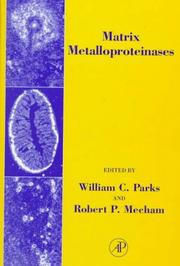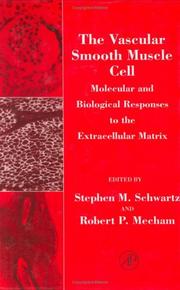| Listing 1 - 6 of 6 |
Sort by
|
Digital
ISBN: 9783642165559 Year: 2011 Publisher: Berlin, Heidelberg Springer Berlin Heidelberg
Abstract | Keywords | Export | Availability | Bookmark
 Loading...
Loading...Choose an application
- Reference Manager
- EndNote
- RefWorks (Direct export to RefWorks)
Chemical structure --- Histology. Cytology --- Molecular biology --- protein-engineering --- cytologie --- histologie --- eiwitten --- moleculaire biologie

ISBN: 0125450907 9780125450904 9780080535982 0080535984 1281057045 9781281057044 Year: 1998 Publisher: London Academic Press
Abstract | Keywords | Export | Availability | Bookmark
 Loading...
Loading...Choose an application
- Reference Manager
- EndNote
- RefWorks (Direct export to RefWorks)
The chapters in this book thoroughly cover the structure, regulation, and function of matrix metalloproteinases, and provide information on the latest strategies to inhibit enzyme activity. This work will be an indispensable reference tool for investigators with an interest in extracellular matrix biology, matrix turnover, enzymology and biochemistry of proteinases, developmental biology, pathology, and therapeutic interventions. Key Features * Provides state-of-the-art information on a field with broad implications to many areas of biology * Includes detailed coverage of the structure and regulation of all major matrix metalloproteinases * Chapters focus on a timely and expanding field * Topics have direct relevance to understanding human disease pathology of cancer, arthritis, and vascular disease * Discusses latest strategies used in the development of new therapeutics to inhibit metalloproteinase activity.
Digital
ISBN: 9783642168611 Year: 2011 Publisher: Berlin, Heidelberg Springer Berlin Heidelberg
Abstract | Keywords | Export | Availability | Bookmark
 Loading...
Loading...Choose an application
- Reference Manager
- EndNote
- RefWorks (Direct export to RefWorks)
Chemical structure --- Histology. Cytology --- General biochemistry --- Molecular biology --- protein-engineering --- biochemie --- cytologie --- histologie --- eiwitten --- moleculaire biologie
Digital
ISBN: 9783642359354 Year: 2013 Publisher: Berlin, Heidelberg Springer
Abstract | Keywords | Export | Availability | Bookmark
 Loading...
Loading...Choose an application
- Reference Manager
- EndNote
- RefWorks (Direct export to RefWorks)
Cells in the developing embryo depend on signals from the extracellular environment to help guide their differentiation. An important mediator in this process is the extracellular matrix – secreted macromolecules that interact to form large protein networks outside the cell. During development, the extracellular matrix serves to separate adjacent cell groups, participates in establishing morphogenic gradients, and, through its ability to interact directly will cell-surface receptors, provides developmental clocks and positional information. This volume discusses how the extracellular matrix influences fundamental developmental processes and how model systems can be used to elucidate ECM function. The topics addressed range from how ECM influences early development as well as repair processes in the adult that recapitulate developmental pathways. The series Biology of Extracellular Matrix is published in collaboration with the American Society for Matrix Biology.
General embryology. Developmental biology --- Histology. Cytology --- Biology --- Human histology. Human cytology --- Immunology. Immunopathology --- stamcellen --- biologie --- cytokines --- cytologie --- embryologie (geneeskunde) --- stamceltransplantatie --- groeifactoren --- histologie
Digital
ISBN: 9783642360022 Year: 2013 Publisher: Berlin, Heidelberg Springer
Abstract | Keywords | Export | Availability | Bookmark
 Loading...
Loading...Choose an application
- Reference Manager
- EndNote
- RefWorks (Direct export to RefWorks)
The evolution of single cells into multicellular organisms was mediated, in large part, by the extracellular matrix. The proteins and glycoconjugates that make up the extracellular matrix provide structural support to cellular complexes, facilitate cell adhesion and migration, and impart mechanical properties that are important for tissue function. Each class of ECM macromolecule has evolved to incorporate distinctive properties that are defined by conserved modules that are mixed together to achieve appropriate function. This volume provides a comprehensive analysis of how the major ECM components evolved over time in order to fill their specific roles found in modern organisms. The major focus is on the structural matrix proteins, matricellular proteins, and more complex ECM structures such as basement membranes. Adhesive proteins and their receptors are also discussed. The series Biology of Extracellular Matrix is published in collaboration with the American Society for Matrix Biology.
Evolution. Phylogeny --- Histology. Cytology --- Biology --- time series analysis --- biologie --- cytologie --- histologie --- Europees recht --- evolutieleer

ISBN: 9780126323108 0126323100 9780080543505 0080543502 Year: 1995 Publisher: San Diego Academic Press
Abstract | Keywords | Export | Availability | Bookmark
 Loading...
Loading...Choose an application
- Reference Manager
- EndNote
- RefWorks (Direct export to RefWorks)
In the last several years, the development of reagents that recognize smooth muscle-specific proteins has enabled researchers to identify smooth muscle cells (SMC) in tissue undergoing both differentiation and repair. These developments have led to increased research on SMC. The latest volume in the Biology of the Extracellular Matrix Series takes a current and all-encompassing look at this growing area of research. Devoted entirely to the subject of SMC, the book covers a diversity of topics-from SMC architecture and contractility to differentiation and gene expression in development. It also examines the proliferation and replication of SMC and its role in pharmacology and vascular disease. A must for cell, developmental, and molecular biologists, this book also will appeal to cardiologists, pathologists, and biomedical researchers interested in smooth muscle cells. Key Features * Presents a molecular, genetic, and developmental perspective of the vas smooth muscle cell * Overview sections highlight key points of chapters, including the clinical relevance of the research and expectations for future study * Appeals to both the basic biologist and to the biomedical researcher of vascular disease.
| Listing 1 - 6 of 6 |
Sort by
|

 Search
Search Feedback
Feedback About UniCat
About UniCat  Help
Help News
News